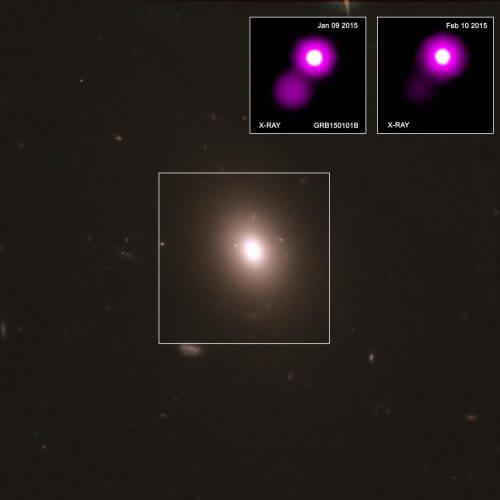According to the researchers, both GRB150101B and GW170817 likely formed from the collision of two neutron stars. During the collision, a narrow jet of high-energy particles known as a gamma-ray burst (GRB) erupted and shot across the universe.

In October 2017, a group of astronomers excitedly announced that they had simultaneously observed gravitational waves from a massive galactic collision between two neutron stars and in the light spectrum. A year later, a second group uncovered another incident, with a striking resemblance to this one.
The event, called GRB150101B, was originally detected as a gamma-ray burst (GRB) by the Fermi Space Telescope operating in the gamma-ray field in January 2015. However, following further studies by a team led by Eleonora Troja from the University of Maryland, USA, astronomers have now determined that It may be caused by the same type of event – a merger between neutron stars – that was detected in the 2017 event known as GW170817. The study was published in the journal Nature Communications.
"It's a big step to go from one identity to two," says Troja. "Our discovery shows that events like GW170817 and GRB150101B could represent a whole new class of objects that turn on and off, and may be a common phenomenon."
According to the researchers, both GRB150101B and GW170817 likely formed from the collision of two neutron stars. During the collision, a narrow jet of high-energy particles known as a gamma-ray burst (GRB) erupted and shot across the universe.
Troja and her colleagues show that there is a striking similarity between the two events. Both produced a short burst of gamma rays followed by bright blue light that lasted for several days and an X-ray emission that lasted for a long time.
It was the blue light that provided the team with an important clue that GRB150101B was involved in a terrible explosion, a thousand times larger than a supernova, known as a kilonova. Although kilonovae were first observed in 2008, and the term was coined in 2010, it was not until the 2017 event that they were discovered to be related to neutron star collisions.
A wonderful similarity between the two events
Using the Hubble Space Telescope and the Discovery Telescope in Arizona, the researchers found that the host galaxies of the two events look remarkably similar. Both are elliptical galaxies with a population of stars several billion years old, with no evidence of new stars.
However, Troja and his colleagues aren't sure if GRB150101B produced gravitational waves in a similar way to 2017 because Advanced LIGO, the facility responsible for collecting the waves from GW170817, was only activated after GRB150101B occurred.
Even if the Ligo observatory was active it would be impossible to detect it, the event of GW170817 occurred about 130 million light years from Earth, but GRB150101B lies about 1.7 billion light years away. Detecting gravitational waves at this distance may be beyond his capabilities.
"They look the same, drive the same and come from similar neighborhoods, so the simplest explanation is that they are from the same family of objects." says Jeffrey Ryan, who was part of the team from the University of Maryland. The absence of gravitational waves means that it is not possible to know if it was really a collision between two neutron stars and not between a black hole and a neutron star.
Researchers now believe that it is possible that mergers such as GW170817 and GRB150101B have been observed by astronomers in the past, but not identified as such. Troja and her team hope that the lessons learned from GRB150101B will allow astronomers to more easily identify similar events in the future.
to the announcement of the university
More of the topic in Hayadan:

One response
Is it expected that the merger of two black holes will be detectable?
"Bashlifa" the immediate answer is no, but on second thought... Isn't it completely safe?
Is it absolutely clear what the impact of the intensity of the collision between two black holes will be on space-time?